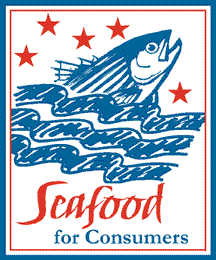
Number 13
June 10, 2000

 |
 |
Heroes to heels....
It wasn’t too long ago that commercial fishermen enjoyed the respect, if not the unqualified admiration, of the general public. This was reflected in the popular literature of the day. Writers as diverse as Rudyard Kipling, Herman Melville, Peter Benchly, Robert Ruark and Ernest Hemingway have all represented fishermen, albeit with blemishes intact, as nearly legendary figures embodying the best of the “manly” virtues while at work and struggling in a harsh environment alien to most readers.The specter of overfishingMore recently the trend has been to depict fishermen either as unnatural predators in our ocean ecosystems, or as despoilers of those same ecosystems. However, this “downsizing” of the public’s image of working fishermen hasn’t been due to the efforts of working writers. Rather, it’s been the result of a focused, extremely well-financed and apparently well-coordinated campaign by various groups and individuals, collectively referring to themselves as “marine conservationists.” They have become adept at attracting and holding the attention of the print and broadcast media by attacking the commercial fishing industry through the selective and often distorted use of isolated snippets of fisheries data, out-of-the-larger-context illustrations of uncommon fishing practices, and grotesque oversimplifications of exceedingly complex and poorly understood natural processes. It’s unfortunate that none of the reporters, researchers or producers that are so diligent when covering the supposed failings of today’s commercial fishermen exhibit a corresponding diligence in gathering background information on those fishermen, their fisheries or on other conditions in the oceanic or estuarine ecosystems they depend on. We’ve seen nothing that comes close to questioning the scientific underpinnings of the campaigns that these “conservationists” are spending millions of dollars to prosecute. Or where they are getting those millions of dollars. Likewise, the media is studiously ignoring what their possible motives - beyond, of course, that inherent altruism that is such a significant part of our multi-billion dollar environmental industry today - might be. In this and the following FishNet we’d like to at least begin to fill some of the more obvious information gaps that are critical, we feel, to a full understanding of the actual condition of the United States’ and the world’s fisheries.
The marine conservation movement has made much of the fact that many of the world’s, and our nation’s, fisheries are at or approaching the level of being “overfished.” Obviously, having a fishery in an “overfished” condition is undesirable. Just as obviously, one would think (if one were dealing in a rational world) that a fishery could only reach the undesirable condition of being overfished through too much fishing. But that’s not the case in the waters under U.S. jurisdiction. As we discussed in a previous FishNet (Then there’s bycatch), in accordance with a recent amendment to the Magnuson-Stevens Act (the federal legislation that sets out how fisheries will be managed in the U.S. Exclusive Economic Zone), any fish stock that isn’t at some arbitrary, and arbitrarily high, level of abundance, no matter what the reason, is termed “overfished.” Too much pollution and not enough fish? Overfishing at work. Filled in wetlands and not enough fish? More overfishing. Low year in the natural cycling of a stock of fish due to el Nino or la Nina? You guessed it - overfishing yet again. Whenever we have a fish stock that isn’t at a high point on the population curve, and no matter what the reason, it’s overfishing that’s held responsible and it’s fishermen who get the blame.
Because of the fact that any noxious material that’s on the land or in the air or water is going to eventually end up in close proximity to a fish or two, there’s a fairly obvious relationship between environmental quality and the health of fish stocks. So, you would think (remember that rational world referred to up above), people and/or groups with an interest in environmental quality - ostensibly marine conservationists fit in here - would do all they could to focus attention on the anthropogenic whys of fish population fluctuations. But, somewhat puzzlingly, this is not the case. Instead, these supposedly environmentally aware folks support this rather incredible method of determining “overfishing” and have taken advantage of it in every media outlet that’s bought into their doom and gloom pronouncements or whichever courtroom they’ve sued their way into. Their goal hasn’t been to help the fish. Determining the actual causes of fish population declines and then pushing for whatever corrective measures, if any, were appropriate would do that. With their slavish and all-consuming focus on making overfishing appear to be the cause of every fishery’s ills, however, it’s hard to imagine that their goal is anything other than to heap blame onto the figurative shoulders of the fishing industry. If it were, their understanding, their agenda and their media outreach would extend far beyond the simple equation “not enough fish equals too much fishing.”
This completely misleading method of representing the health of a fish stock surely isn’t of any value to an understanding of what’s going on in our estuarine, coastal and offshore waters. If too much fishing is the culprit, identify it as such and then fix it. But if fishing isn’t to blame, identify what really is and then fix that. But this is a path seldom if ever travelled by the “conservationists.” Rather, they support a policy that automatically turns commercial fishermen into bad guys; targets ripe for their expensive multimedia campaigns. Should such a jaundiced perspective be a part of any rational fisheries management policy? Congress obviously thinks so, or at least thought so when the Magnuson-Stevens Act was last amended, and when the conservationists, with the assent of the managers in Washington, extended extreme pressure to have it included. However, the distortions it’s causing in the management system are obvious (see the box on the current dogfish situation). The attendant economic and social damages to fishing communities up and down the coasts, while not so obvious, are severe.
Bycatch refers to those organisms that are harvested inadvertently along with the targeted species that fishermen are seeking. Sometimes bycatch species are valuable, are retained by the fishermen, and are sold along with the targeted harvest. Sometimes bycatch has no value and is returned to the ocean, sometimes alive and sometimes not. And sometimes bycatch could be sold except for the fact that management regulations won’t permit it. This is termed “regulatory bycatch” and is responsible for the senseless waste of many tons of high quality seafood every year.Generally speaking, commercially and recreationally desirable fish and shellfish species are found in our estuaries and oceans in intermingled assemblages. It’s not uncommon to find individuals of several species intimately associated, either on the same area of sea floor or in the same volume of water. Even vast schools of particular species will have other species mixed in or on the periphery. This makes it exceedingly difficult - at least when considering commercial fishing gear efficient enough to provide consumers with affordable seafood or recreational fishermen possessing average skill levels - to harvest only the targeted species. However, the talent of the fisherman, whether commercial or recreational, and gear modifications can minimize bycatch. This is something that every fisherman is committed to, not just because the idea of needless killing is repugnant, but also because catching fish or shellfish that you can’t sell comes with a serious set of economic disincentives including increased wear and tear on the fishing gear and increased crew expenses for culling (sorting) the catch.
But how bad, biologically speaking, is bycatch? Like almost every other question dealing with fisheries issues, it depends. It depends on the species taken as bycatch, on the age/size of the species, and on where the fishing is taking place.
Marine fish and shellfish are characterized by their high fecundity, particularly when judged by terrestrial standards. Many release millions of eggs, and even the sharks - whose supposedly “low” reproductive potential puts them, in the conservationists agenda, in danger of overfishing - produce from several to dozens of fully functional young every year. Needless to say, this high reproductive potential is balanced, is in fact required, by naturally high mortality levels. If it weren’t, in fairly short order we’d be up to our ears in dogfish or codfish or scallops. In fact, it’s probably safe to say that at least 99.99% of all marine organisms spawned in the world’s oceans never come close to reaching maturity. As far as the biological success of those species are concerned it doesn’t matter what the source of that mortality is. On the average one spawning pair of red snapper in the Gulf of Mexico will produce two mature red snapper. Millions of fertilized eggs, hundreds of thousands of larvae, thousands of juveniles and hundreds of immature snapper produced by these spawners will die every year. Whether they become dinner for a larger fish, are a casualty of “catch and release” recreational fishing size limits, or end up on the deck of a shrimper makes no difference to the overall red snapper population.
What does make a difference is whether large enough numbers of a particular size/life stage of a species survive the various forms of natural and man-made mortality to sustain the species at a desirable level. Seeing that fish stocks reach this level, rather than automatically condemning all forms of bycatch, should be the immediate focus of bycatch reduction efforts in fisheries mangement. Our ultimate goal is, as it should be, the elimination of all bycatch mortality, for practical as well as philosophical reasons. Bycatch costs fishermen money. If bycatch mortality for a particular life stage is keeping a species below the “sustainable” level, then we should certainly be doing as much as we can to correct the situation, but to attempt to demonize the entire commercial fishing industry for bycatch mortality that has no impact on particular fisheries, particularly when the industry is doing all that it can to reduce that mortality anyway, makes no sense, either biologically or economically.

![]()
| FishNet USA is distributed to over 1500 elected and appointed officials, media representatives, individuals and organizations with an interest in fisheries issues via fax and email. It is supported by Atlantic Capes Fisheries, the Fishermen’s Dock Cooperative, Lund’s Fisheries, Export, Inc., Agger Fish Corp., Viking Village Dock, The Belford Seafood Coop and Hi-Liner Fishing Gear. |